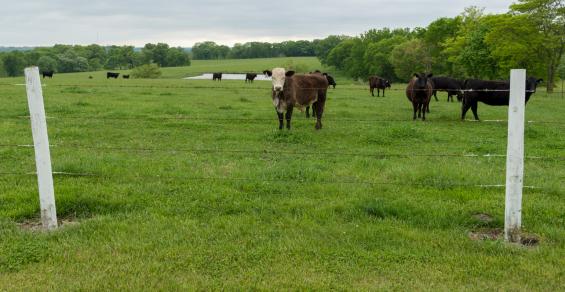Reduce grass tetany in cattle through grazing practices and mineral supplementation.
This spring, cattle producers may see cows get a swagger about them as they graze new grass, but it is not a sign of confidence.
Grass tetany, or as some call it “grass swaggers,” is a metabolic disease caused by a low level of magnesium in the blood. Patrick Davis, University of Missouri Extension livestock specialist, says some factors contributing to these low magnesium levels include reduced dietary intake, mineral imbalances that reduce absorption and metabolic activities such as milk production that cause high magnesium release. Ultimately, grass tetany can lead to an animal’s sickness or death.
Incidences of grass tetany in cattle occur most often in the spring, after a cool period when temperatures range between 45 and 60 degrees F when grass is growing rapidly. It affects ruminant livestock such as beef cattle, but also dairy cattle and sheep.
Management of beef cattle and supplementation strategies can reduce occurrences of grass tetany.
Protect those prone to grass tetany
“Older cows in early lactation are the most susceptible to grass tetany,” Davis explains. During early lactation, cows are producing large amounts of milk that result in a high release of magnesium. This combined with an older cow’s reduced ability to mobilize bone magnesium leads to low blood magnesium levels and grass tetany symptoms.
Davis urges cattle producers to reduce disease potential through grazing management. Graze less susceptible animals such as dry cows, heifers, stocker cattle and cows nursing calves more than 4 months old on high-risk, lush-green pastures. If possible, delay turnout until plants are 6 inches tall.
Cattle producers may also want to consider providing hay while cattle are grazing spring pastures.
Long-term management options include planting more legumes into pasture mixes as they have higher levels of magnesium and calcium than immature grass and provide a balance.
Add in mineral supplements
Unfortunately, grazing new spring pasture is a must for some farmers who have run out of winter forage. The risk comes as the combination of high potassium and low sodium in lush forage growth reduces magnesium absorption and utilization.
While magnesium deficiency leads to grass tetany, Davis says, recent evidence implicates sodium deficiency in grass tetany issues. There is a way to mitigate the risk of both.
A balanced mineral program that provides salt and magnesium supplementation free choice to cattle can help reduce the incidence of grass tetany. Davis also suggests feeding a high-magnesium mineral — 12% to 14% magnesium as magnesium oxide — about 30 days before green-up.
Symptoms and treatment
Signs of grass tetany in a cattle herd include:
unusual behavior
separation from herd
muscle tremors
frequent urination
hypersensitivity to touch
staggers
convulsions
coma
Typically, grass tetany can be treated with an intravenous dextrose-based commercial preparation of magnesium and calcium from a local veterinarian. Davis urges cattle producers to visit with their veterinarian and plan treatment protocols in case cattle exhibit these symptoms, because swift action may lead to saving the animal.
Losses due to grass tetany can negatively affect operation productivity and profitably, he adds.
For more information on prevention of grass tetany in your cattle operation, contact your local Extension livestock specialist.
University of Missouri Extension and South Dakota State University contributed to this article.




